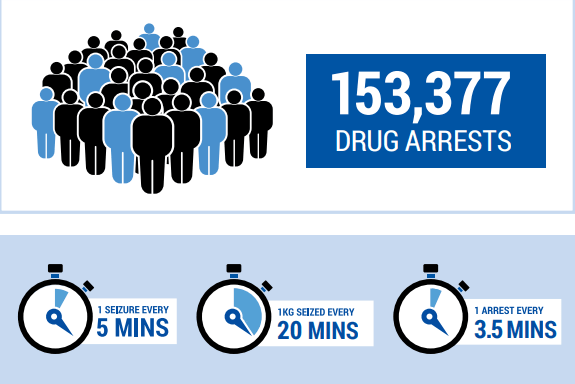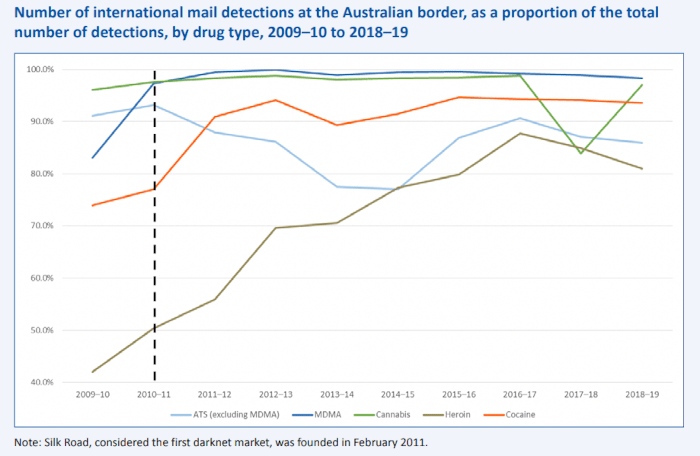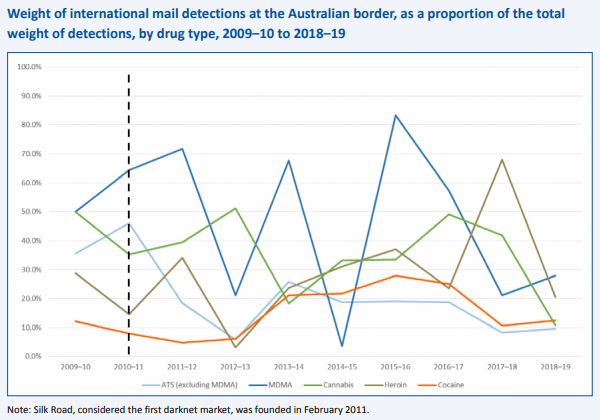ACIC Report: Internet Is an “Established” Source of Drugs
Darknet drug markets are partially responsible for record high drug seizures at the Australian border, according to a report by the Australian Criminal Intelligence Commission.
Earlier this month, the Australian Criminal Intelligence Commission released their 2018 to 2019 Illicit Drug Data Report. In it, they highlighted a number of trends among drug users in Australia. Australians set new records in the period covered in the ACIC’s report, including:
- 5.1 tonnes of amphetamine type stimulants (excluding MDMA) detected at the Australian border;
- 5,378 national cocaine seizures;
- 5,016 national cocaine arrests;
- 1,029 national hallucinogen arrests;
- 1,363 anesthetic detections at the Australian border.
“Over the last decade, during which time the Australian population increased around 13 per cent, the number of national illicit drug seizures increased 77 per cent, the weight of illicit drugs seized nationally increased 241 per cent and the number of national illicit drug arrests increased 80 per cent with 153,377 arrests in 2018–19.”
“In Australia, while there are limited supply and demand indicators directly linked to online illicit drug purchases, available data suggest that online markets are a relatively niche, but nonetheless established, source of illicit drugs,” according to the report.
Over the last decade, the number of detections of drugs in the mail stream increased. During the same time, the weight detected decreased. There is an exception for the number of amphetamine type stimulants and the weight of cocaine which decreased and increased respectively.
Heroin reported the greatest increase in the proportion of international mail stream detections over the last decade, which almost doubled from 2009–10 to 2018–19. By weight, the proportion of international mail stream detections of amphetamine type stimulants, MDMA, heroin, and cannabis fluctuated over the last decade, though overall the proportions decreased.
The proportion of cocaine detections (by weight) in the international mail stream also fluctuated, though to a lesser extent, and overall remained relatively stable between 2009–10 and 2018–19.
The Ecstasy and Related Drugs Reporting System (EDRS) collects self-report information on drug use and related harms people in Australian capital cities who regularly use ecstasy and other stimulants. In 2019, 73 percent of respondents arranged the purchase of illicit or nonprescribed drugs via social networking applications in the past year. Ten percent of respondents had purchased drugs on the darkweb in 2019. Five percent had purchased drugs from a source on the clearnet. Roughly the same number of respondents who had purchased drugs on the darkweb reportedly received drugs through the mail system within the last 12 months.
The Drug Use Monitoring in Australia (DUMA) program collects criminal justice and drug use information from people in police custody. In 2014, the DUMA program interviewed police detainees on the topic of purchasing drugs on the internet. Thirty one per cent of respondents had sourced information about drugs online but only five per cent of respondents had purchased drugs online. Respondents most commonly purchased methylamphetamine (42 per cent), cannabis (27 per cent), MDMA (27 per cent), pharmaceuticals (20 per cent), heroin (14 per cent), and alcohol (7 per cent). However, in 2018, only 59 percent of respondants had used a mobile device to buy or sell illegal substances. Of those interviewed, 53 percent of respondents had used simple messaging applications to source their substances. “Findings of this study again illustrate that not all drug dealing using technology involves encrypted communications and how technology may be used to facilitate drug transactions,” the ACIC report said.
The ACIC report covered the differences in drug prices on the street and available on darkweb markets. “Although prices vary among suppliers based on the drug’s ‘quality’ and market demand, in general drug prices on the darknet—particularly for methylamphetamine and MDMA—are reportedly cheaper than local street prices.” In the 2018-19 period covered in the report, the average price for one gram of methylamphetamine on the darkweb was $179. In Victoria during the same period, a gram of methylamphetamine was $200 with a national median street price of $38.
MDMA prices were also better on the darkweb. The price for one gram of MDMA on the darkweb was $79. In Victoria, the price for one gram of MDMA ranged from between $100 and $200 with a national median street price of $200. According to the report, the prices of heroin and cocaine on the darkweb were similar to their local prices.
In 2018–19, 2,890 drug seizures were linked to online purchases. The breakdown:
- 1,234 seizures (43 per cent) were cannabis
- 741 seizures (26 per cent) were methylamphetamine
- 410 seizures (14 per cent) were cocaine
- 387 seizures (13 per cent) were MDMA
- 118 seizures (4 per cent) were heroin.
In 2018–19, 52,956 grams of illicit drugs seized nationally was linked to online purchases. The breakdown:
- 41,031 grams (77 per cent) was cannabis
- 4,851 grams (9 per cent) was MDMA
- 4,704 grams (9 per cent) was cocaine
- 2,118 grams (4 per cent) was methylamphetamine
- 249 grams (<1 per cent) was heroin
Law enforcement in Australia responded to the increase in online drug sales with a range of responses, including:
- Operation Vitreus―while not specifically focused on darknet activity, work completed as part of semi-regular weeks of action includes a national mail screening operation to detect and disrupt the flow of illicit drugs through the Australian postal service. By focussing on drug detections in the mail stream, it is possible to disrupt some movement of drugs sourced from darknet markets. Specific operations conducted as part of Operation Vitreus include Operation Detect in Queensland and Operations Outpost and Viridian in Victoria.
- Strike Force Royden (New South Wales Police Force)―to investigate an online darknet vendor.
- Joint Task Force Icarus (Victoria Police in partnership with the AFP, the Australian Border Force (ABF) and the Department of Home Affairs (DHA))―worked closely with Operation Vitreus to target illicit drug distribution through the domestic mail stream.
- Operation Salamanca (Victoria Police)―commenced in June 2018 to target vendors advertising on the darknet ‘Dream Market’.
- Operation Parthenon (Northern Territory in partnership with the AFP, ABF, DHA and ACIC)―established to investigate the use of cryptocurrency and darknet markets to order illicit drugs from international suppliers.
- Joint Agency Ice Strike Team (led by South Australia Police)―a multi-agencytaskforce commencing in February 2019 targeting the importation and trafficking of methylamphetamine, its precursors and other high risk and emerging drugs into South Australia via air cargo, sea cargo and the domestic and international mail streams, and the identification of the international origins and supply chains of related significant domestic seizures
Finally, the report also described the operation led by law enforcement in the United States and in the Netherlands that resulted in the seizure of Alphabay and Hansa Market.
“Lessons learnt from the take down of Silk Road were applied to the take down of AlphaBay and Hansa, in particular the tendency of online users to switch almost immediately from one online market to another. In effect, the international collaboration meant that many AlphaBay users transitioned to Hansa, which was law enforcement controlled at the relevant time. This example demonstrates the scope of the issue and the necessity of close international collaboration to take down online marketplaces of this type. Law enforcement agencies worldwide benefit from such take downs through receipt of data on buyers and sellers, which may generate follow up investigations in Australia and elsewhere.”


